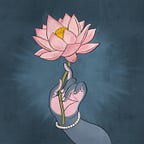Kṛṣṇa Temple in Patan
The beautiful Kṛṣṇa Temple at Durbar Square in Patan, Nepal was built in 1637 by King Siddhi Narasiṃha of the Malla dynasty, who is said to have dreamt that Kṛṣṇa and Rādha appeared in front of his palace and so he erected a temple on that spot to celebrate their love. It is among the few in the valley built in the Indian style with a tapering śikhara. King Siddhi Narasiṃha also created the intimate courtyard of Sundari Chowk and the huge gardens behind this palace.
King Siddhinarasiṃha Malla was awarded the great honor of being called “the great saint on the lion throne”. The king was fond of satsaṅga, associated with holy men and took pilgrimages to Benares and other religious centers often. He was also praised as a great sage among kings (rājarṣi) in the Vamśagōpāla copper plate inscription, and true to his name, he voluntarily abdicated his throne, and after personally crowning his son Śrīnivāsa, left for Benares in the year 1661.
King Siddhinarasiṃha was a great devotee of Kṛṣṇa and built the Bālagopāla Temple in Patan in honor of the youthful cowherd (Bālagopāla) in 1637.
A devotional Vaiṣṇava cult of Kṛṣṇa Bhakti gradually developed centered around the temple. The sanctuary on the first floor of the temple houses Kṛṣṇa with two smaller mūrtis of Rukmiṇī and Satyabhāma. The outer walls are decorated with stone reliefs of the Daśāvatāta, the upper storey with scenes from the Mahābhārata and the lower with those from the Rāmāyaṇa.
An accomplished poet himself, he composed romantic Kṛṣṇalīla poetry inspired by the style of the Gīta Govinda in 1640–60, written in an older, literary or classical form of Newari. The poems to Kṛṣṇa written by King Siddhinarasiṃha Malla are illustrated in a narrative scroll painting now displayed at the Patan Museum. Every year at Holi the Kṛṣṇalīla painting is taken and displayed at the Kṛṣṇa Mandir, celebrated pomply with songs and recitation.
The translation of the opening composition, describing the entrancing and beautiful appearance of Śri Kṛṣṇa as Veṇudhāra, is expressed in the words of a gopi. It is sung in the rāga Bhaṭiyār.
“Round his crown are bound peacock feathers (intertwined with a thread), making his head beautiful to look at. On his forehead, a ṭīka made of saffron. He is incomparable.
Indeed, I do not know how to describe Kṛṣṇa’s appearance to a rasika. When he played the flute beneath the Kadamba tree, my mind became infatuated with him.
His full-moon face is as bright as the moon and an auspicious place for earrings. His pupils are beautiful, his eyes are the shape of lotus petals.
His body is the color of a saphhire, round his neck is a garland of jasmine. When we look at him, we quickly swoon. Love has ensnared us.
As long as you may behold a vision of Gopīnatha, the Lord of (King) Siddhinarasiṃha, forget, o mind, my temple, your royal duties, the burden of household and family.”
The next song (in the rāga Kauśika) also describes the beauty of Kṛṣṇa, and how he is won not by austerities and yogic endeavors but by ardent and deeply-felt love.
“I looked at the beauty of his full-moon face, which, unlike the moon, does not wane from fortnight to fortnight.
Above the jewel of his heart is the charm of his smile. He caresses the serpant Kālīya as if to bestow liberation upon it.
You do don’t claim munis (sages) as your devotees in spite of their yoga and austerities, you respect them with only a half-open eye, Gōpāla!
You display the brilliance of your earrings, made of rubies and pearls.
Two long strings of peals adorn your conch-shaped neck.
A mind confined to the heart, the house of love, befits you, just as the Cakravāka-pair* rest on lotus-stalks claiming them as food.
No comparison comes to mind, no description of the art of love will truly last. Gōpīnātha, Lord of King Siddhinarasiṃha, is sufficient.”
*Cakravāka (the ruddy goose or Brahmany duck) in Sanskrit literature represents longing. The pair are said to be lovers, cursed to eternal nocturnal separation after disturbing the meditation of a sage in a past life. All night, await the arrival of day to be reunited.
References:
The Divine Play of Lord Krishna: A Krishnalila Painting from Nepal by Siegfried Lienhard
______________________________________________________________
If you find value in my work, I hope you consider becoming a patron through Patreon. Hindu Aesthetic requires a lot of time and effort and your support would mean that I can continue bringing you the highest quality content. Link to my Patreon:
